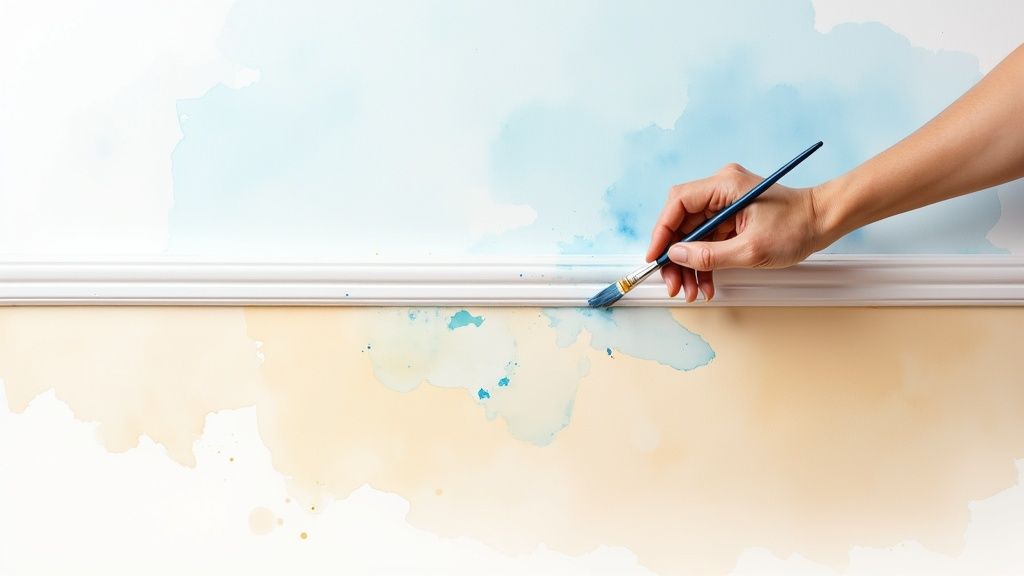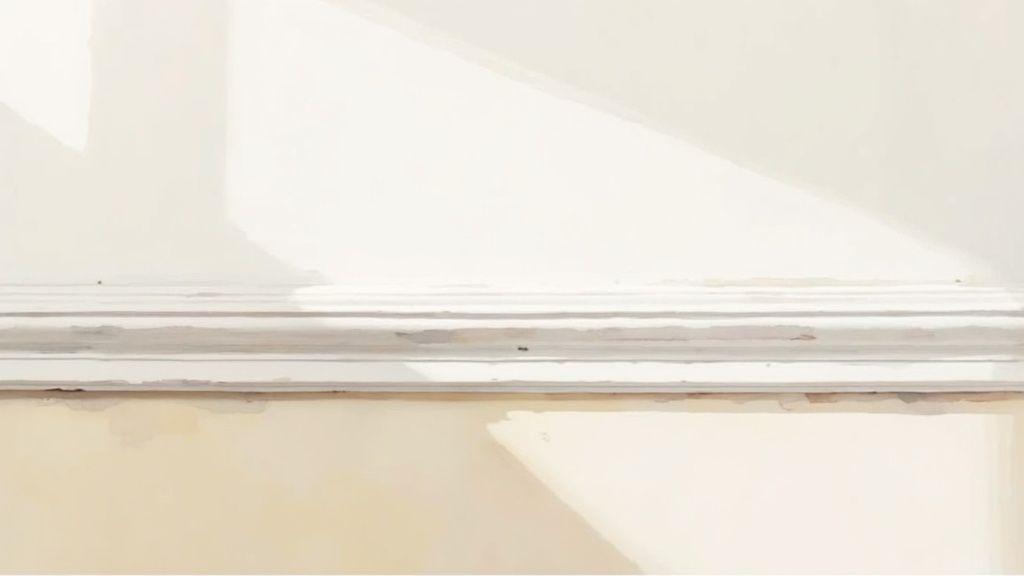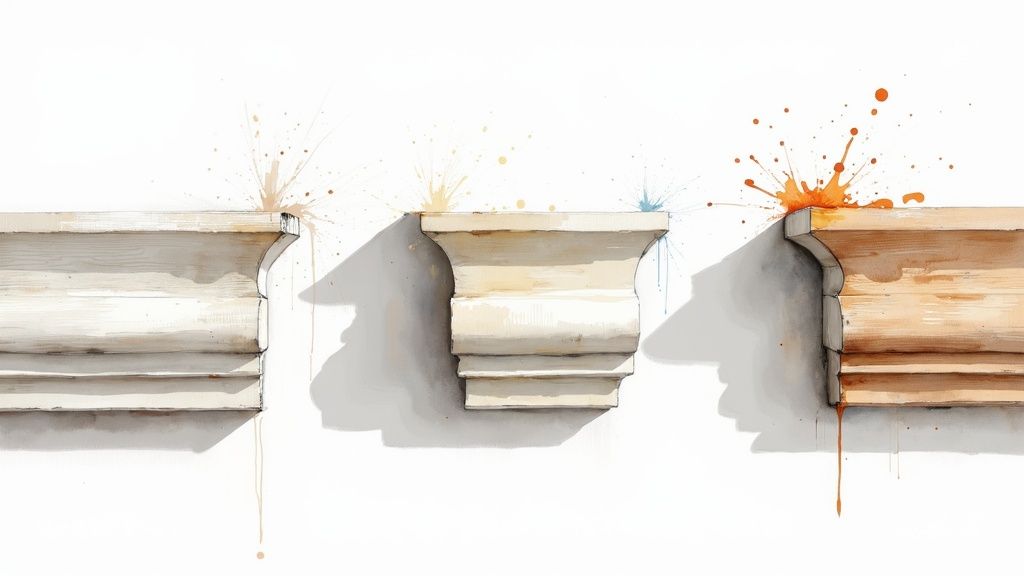What Is Chair Rail and Why It Belongs in Your Home

Ever wondered about that strip of molding running horizontally across a dining room wall? That’s a chair rail, and while it looks like a purely decorative touch, its story starts with a very practical job: protecting walls from the backs of chairs.
Today, though, it’s so much more. It’s a simple but powerful design element that can add a ton of architectural character and visual flair to almost any room.
What Is a Chair Rail’s True Purpose?

At its core, a chair rail is a stylish bumper for your walls. Think about a busy dining room—chairs are constantly being pushed back, and without a buffer, you’d end up with a mess of scuffs, dents, and scrapes. The chair rail was born to take that abuse.
But like many classic architectural features, its role has expanded far beyond its original, practical purpose. Now, the main reason people install a chair rail is for the visual punch it delivers. It adds a touch of timeless elegance and structure, acting as a visual anchor that can make a plain wall feel thoughtfully designed.
Blending Form and Function
The real magic of a chair rail lies in how it seamlessly merges practicality with aesthetics. It’s a workhorse and a show pony all in one.
It creates a natural dividing line on the wall, opening up a world of creative possibilities. Designers often use this line to play with two different paint colors—maybe a darker, more durable shade on the bottom and a lighter one on top. It’s also the perfect transition point for wainscoting or wallpaper, giving the room a custom, layered feel that feels anything but flat.
A well-placed chair rail doesn’t just protect the wall; it defines the room’s character. It breaks up vertical space, making ceilings feel proportionate and adding a layer of architectural detail that elevates the entire interior.
So, when we ask what is chair rail, the answer has evolved. It’s no longer just a functional piece of wood; it’s a versatile design tool that brings balance, style, and a classic finish to a room’s decor.
The Surprising Origins of Wall Molding
You might think chair rails were always meant for, well, chairs. But their story is much older and far more interesting than that. Long before they served as a buffer for dining room furniture, their early ancestors adorned the walls of ancient Greek and Roman buildings.
In these classical designs, moldings weren’t for protection. They were all about proportion. Architects used them to divide large wall spaces into more visually pleasing sections, creating a sense of order and architectural harmony. It was a purely aesthetic choice.
This decorative purpose held strong for centuries. It wasn’t until the 16th century that the chair rail we know today took on its more practical role in Europe and colonial America. As dining rooms became the heart of the home, this simple strip of wood was installed at the perfect height—usually around 24 to 36 inches from the floor—to take the brunt of bumps and scrapes from constantly shifting chairs.

This journey from an aesthetic ideal to a functional guard shows how design naturally adapts over time. Today, we’ve come full circle, with many homeowners installing chair rails once again for their visual appeal.
A Tale of Form and Function
The history of the chair rail is a classic story of form meeting function. It’s a perfect example of how an architectural element can be both beautiful and useful, and different cultures have put their own unique spin on it.
Just look at the Shakers, a community celebrated for their minimalist and incredibly clever craftsmanship. They developed a functional twist on the chair rail they called the peg rail. This was a simple wooden board with pegs that ran along the walls of their rooms, and it was brilliant.
- Ultimate Organization: Chairs, brooms, hats, and even clocks could be hung up off the floor.
- Practical Living: This kept rooms uncluttered and easy to clean, perfectly reflecting their values of order and simplicity.
The Shaker peg rail is a fantastic reminder of how a basic wall molding can be completely reimagined. It shows that the core idea—a horizontal line breaking up a wall—has always been a launchpad for both artistry and practical problem-solving.
From the grand temples of antiquity to busy colonial homes and spartan Shaker communities, the history of what is chair rail is a story about the constant interplay between how we want our homes to look and how we actually live in them. This rich past is exactly why it remains such a timeless and versatile feature today.
From Dado Rail to Decorative Detail

As you dive into the world of wall molding, you’ll almost certainly bump into another term that’s often used interchangeably with chair rail: the dado rail. While we tend to use them to mean the same thing today, their historical connection tells a richer story about how this architectural element came to be.
Originally, the “dado” wasn’t the molding at all—it was the entire lower portion of the wall. The dado rail was the piece of trim that capped this section, marking a clear visual split between the bottom and top of the wall. You can find this feature in grand European homes dating all the way back to the Middle Ages and Renaissance.
A Symbol of Status and Craftsmanship
Back then, the dado rail was doing double duty. Yes, it protected delicate plaster walls from being scuffed by furniture (and maybe even a suit of armor in the grandest homes), but it also became a powerful symbol of wealth and sophisticated taste.
As time went on, particularly during the Renaissance and later the Victorian era, these moldings got more and more elaborate. Think intricate carvings, complex profiles, and expensive finishes. The more ornate the molding, the more affluent the homeowner.
The decorative role became every bit as important as the practical one. This wasn’t just a bumper for the wall; it was a canvas for showing off incredible craftsmanship and the owner’s social standing. You can discover more about the history of the dado rail and its evolution over at Panelling Direct.
This shift from purely functional to highly decorative is key. The dado rail’s history shows how a practical architectural element can become a focal point for artistry and design, a tradition that modern chair rails continue.
Today’s chair rails are a direct nod to this legacy. While they might be simpler in form, they still lean on the same classical design principles. By dividing a wall into more pleasing proportions—often using the classic “rule of thirds”—they bring a sense of balance and elegance to a room.
It’s a timeless technique that adds architectural interest and stops a wall from feeling like one big, flat, boring surface. This just goes to show that good design truly stands the test of time.
Choosing the Right Chair Rail Style for Your Home
https://www.youtube.com/embed/qkgOrr565Vo
Once you’ve wrapped your head around what a chair rail is, the fun part begins: picking the perfect one. This is all about finding a sweet spot between your home’s existing architecture, your personal taste, and some real-world practicalities. A great chair rail should feel like it was always meant to be there, not like an afterthought.
The first thing to look at is the molding’s profile. Does your home lean modern or minimalist? A sleek, flat-faced, or simply beveled profile will fit right in. If you’re working with a traditional, colonial, or Victorian space, you’ll want to look for something with more personality—ornate profiles with elegant curves and intricate details.
Matching Material to Your Needs
What your chair rail is made of matters just as much as how it looks. The material directly impacts the final cost, how well it holds up over time, and how easy it is to install. Let’s break down the most common choices.
Comparing Common Chair Rail Materials
Choosing the right material for your chair rail can feel overwhelming, but it really comes down to your budget, the room’s function, and the look you’re after. This table compares the most popular options to help you decide.
| Material | Pros | Cons | Best For |
|---|---|---|---|
| Solid Wood | Timeless, high-end appearance with sharp, crisp details. Extremely durable. | More expensive; can expand or contract with humidity changes. | Formal living rooms, dining rooms, and historic homes where authenticity is key. |
| MDF | Budget-friendly and dimensionally stable (won’t warp). Smooth surface for painting. | Susceptible to water damage; details aren’t as sharp as real wood. | Bedrooms, hallways, and projects where cost is a major consideration. |
| Polyurethane | Lightweight, completely waterproof, and rot-resistant. Easy to install. | Can sometimes look less authentic than wood; may be more expensive than MDF. | Bathrooms, basements, or any space with high moisture. |
Ultimately, the material you pick should align with both your aesthetic goals and the practical demands of the space.
Getting the Scale and Proportions Right
Just as important as style is the scale of the molding. A grand room with soaring 10-foot ceilings can easily handle a wider, more substantial chair rail, adding to the room’s stately feel. But in a standard room with 8-foot ceilings, that same wide molding would feel clunky and out of place. Here, a thinner, more delicate profile is the way to go for a balanced look.
A common mistake is choosing a molding that’s either too big or too small for the space. You’re aiming for harmony. The chair rail should complement the room’s proportions, not fight them.
Finally, think about how the chair rail will play with your wall treatments. This is where your creativity can really shine. A chair rail is the perfect excuse to experiment with two-tone walls, wainscoting, or even wallpaper. Getting a feel for current Modern Home Decor trends can offer some great inspiration. And since the rail acts as a natural divider, knowing how to choose color schemes will help you pull the whole look together beautifully.
How to Find the Perfect Chair Rail Height

When you’re installing a chair rail, you’re not just tacking a piece of wood to the wall—you’re defining the room’s proportions. Get the height wrong, and the entire space can feel off-kilter. But don’t worry, finding that perfect sweet spot is actually pretty straightforward once you know the tricks of the trade.
The go-to guideline for most designers today is the classic rule of thirds. The idea is simple: divide the wall into thirds and place the chair rail about one-third of the way up from the floor. This creates a visual balance that just feels right to the human eye.
For a standard 8-foot ceiling (that’s 96 inches), you’d want the top of your chair rail to hit the wall right around 32 inches from the floor. This simple math keeps everything looking proportional.
Historical Heights and When to Break the Rules
Another way to think about it is to go back to the source. The original purpose of a chair rail was, well, to stop chairs from scuffing the walls. This practical origin gives us another trusted measurement. Most dining chair backs land somewhere between 30 and 36 inches high, and for centuries, this was the default height for installation. It’s a classic range that still works beautifully today.
Of course, not every room is a perfect box. Rules of thumb are a starting point, not an unbreakable law. Here are a couple of common situations where you might want to adjust:
- Tall or Vaulted Ceilings: In rooms with soaring ceilings, the one-third rule can place the rail uncomfortably high. In these cases, it’s often best to ignore the ceiling height and stick closer to that traditional 30–36 inch range.
- Aligning with Windows: Take a look at your windows. If you have prominent sills, lining up the top of the chair rail with the bottom of the windowsill creates a powerful, unified line that pulls the whole room together.
Ultimately, you’re aiming for a line that makes sense with the room’s architecture. Use these guidelines, but also trust your eye. The goal is a polished, intentional look that feels like it’s always been there.
Creative Ways to Use Chair Rail Today
Think a chair rail is just a glorified bumper for your dining room walls? Think again. These days, it’s one of the most adaptable tricks in a designer’s playbook, a simple way to add bespoke character and architectural interest to just about any space. The key is to forget its old-school job and see it for its creative potential.
One of the smartest modern applications is using a chair rail as the perfect finishing touch for wainscoting or beadboard. It creates a crisp, deliberate line between the lower wall paneling and whatever you have going on above—be it paint, wallpaper, or plaster. The effect is a rich, layered look that feels incredibly custom.
This simple addition brings instant structure and a touch of elegance, turning a flat, forgettable wall into a true feature. For more ways to elevate your space, you can find a ton of easy home decor ideas that build on this classic detail.
Defining Spaces and Adding Drama
In today’s open-plan homes, a chair rail can work wonders as a subtle room divider. By running a single line of molding across a large, open area, you can visually fence off a dining nook from the living room without ever putting up a wall. It’s a clever architectural cue that helps create distinct functional zones.
Another fantastic technique is to create picture frame molding, sometimes called box molding. This involves framing out sections of your wall with molding, either above or below the main chair rail, to form elegant squares or rectangles.
This is a go-to method for designers looking to inject a sense of classic formality and grandeur. The shadows and highlights created by the boxes give walls incredible depth, instantly elevating entryways, dining rooms, and primary bedrooms.
Whether it’s serving as a logical cutoff for a two-tone paint scheme or forming the foundation for sophisticated wall paneling, the modern chair rail is packed with possibilities. It’s one of the most affordable ways to make a massive impact.
A Few Lingering Questions About Chair Rails
Even after covering the basics, a few questions tend to pop up when homeowners start thinking seriously about adding chair rail molding. Let’s tackle some of the most common ones.
Are Chair Rails Out of Style?
Not in the slightest. It’s true they have a long history, but think of them as a timeless architectural feature, not a fleeting trend.
The secret to making them feel current is all in the execution. A clean, simple profile can look incredibly sharp in a modern home, while a more ornate design feels right at home in a traditional space. When done right, they always add a touch of class.
Can I Put a Chair Rail in Any Room?
You absolutely can. While dining rooms are the classic spot, chair rails are surprisingly versatile. They bring a dose of architectural character to living rooms, hallways, bedrooms, and even bathrooms.
They’re a fantastic solution for any space where you want to protect the walls, add visual interest, or create a clean dividing line for two different wall treatments, like paint and wallpaper.
So, what’s the difference between a chair rail and wainscoting? It’s simple: the chair rail is just the single strip of horizontal molding. Wainscoting is the decorative paneling that covers the lower portion of the wall, and a chair rail is often used to cap it off.
Getting these basic terms straight is the first step. If you’re looking for more advice on pulling together design elements like this, our guide on interior design tips for beginners is a great place to start.